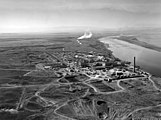Portal:Technology/Selected articles/34
The Hanford Site is a decommissioned nuclear production complex on the Columbia River in south-central Washington operated by the United States government. Established in 1943 as part of the Manhattan Project, it was home to the B-Reactor, the first full-scale plutonium production reactor in the world. During the Cold War, the project was expanded to include nine nuclear reactors and five massive plutonium processing complexes, which produced plutonium for most of the 60,000 weapons in the U.S. nuclear arsenal. Nuclear technology developed rapidly during this period, and Hanford scientists produced many notable technological achievements. However, many of the early safety procedures and waste disposal practices were inadequate. Government documents have since confirmed that Hanford's operations released significant amounts of radioactive materials to the air and to the Columbia River, threatening the health of residents and ecosystems. Today, Hanford is the most contaminated nuclear site in the United States and is the focus of the nation's largest environmental cleanup effort. While most of the current activity at the site is related to the cleanup project, Hanford also hosts a commercial nuclear power plant, the Columbia Generating Station, and various centers for scientific research and development.

